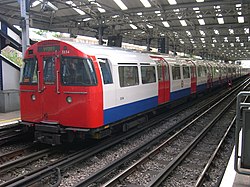| Bakerloo line | |
|---|---|
 A southbound 1972 Stock Bakerloo Line train at Queen's Park | |
| Overview | |
| Stations | 25 |
| Colour on map | Brown |
| Website | tfl |
| Service | |
| Type | Rapid transit |
| System | London Underground |
| Depot(s) |
|
| Rolling stock | 1972 Tube Stock |
| Ridership | 125.662 million (2019)[1] passenger journeys |
| History | |
| Opened | 10 March 1906 |
| Last extension | 1917 |
| Technical | |
| Line length | 23.2 km (14.4 mi) |
| Character | Deep level |
| Track gauge | 1,435 mm (4 ft 8+1⁄2 in) standard gauge |
The Bakerloo line (/ˌbeɪkərˈluː/) is a London Underground line that runs from Harrow & Wealdstone in suburban north-west London to Elephant & Castle in south London, via the West End. Printed in brown on the Tube map, it serves 25 stations, 15 of which are underground, over 23.2 kilometres (14.4 mi). It runs partly on the surface and partly through deep-level tube tunnels.
The line's name is a portmanteau of its original name, the Baker Street and Waterloo Railway.[2] From Queen's Park to Harrow & Wealdstone (the section above ground), the line shares tracks with the London Overground Lioness line and runs parallel to the West Coast Main Line. There is, however, a short tunnel at the western end of Kensal Green.
Opened between 1906 and 1915, many of its stations retain elements of their design to a common standard: the stations below ground using Art Nouveau decorative tiling by Leslie Green, and the above-ground stations built in red brick with stone detailing in an Arts & Crafts style. It is the ninth-busiest line on the network, carrying more than 125 million passengers annually.
The line currently runs 1972 Stock trains which, at 52 years old, are the oldest trains in regular passenger service in Britain.
- ^ "London Assembly Questions to the Mayor". London Assembly. 2022. Retrieved 29 February 2024.
- ^ "The Bakerloo line". London Transport Museum. Retrieved 27 March 2022.